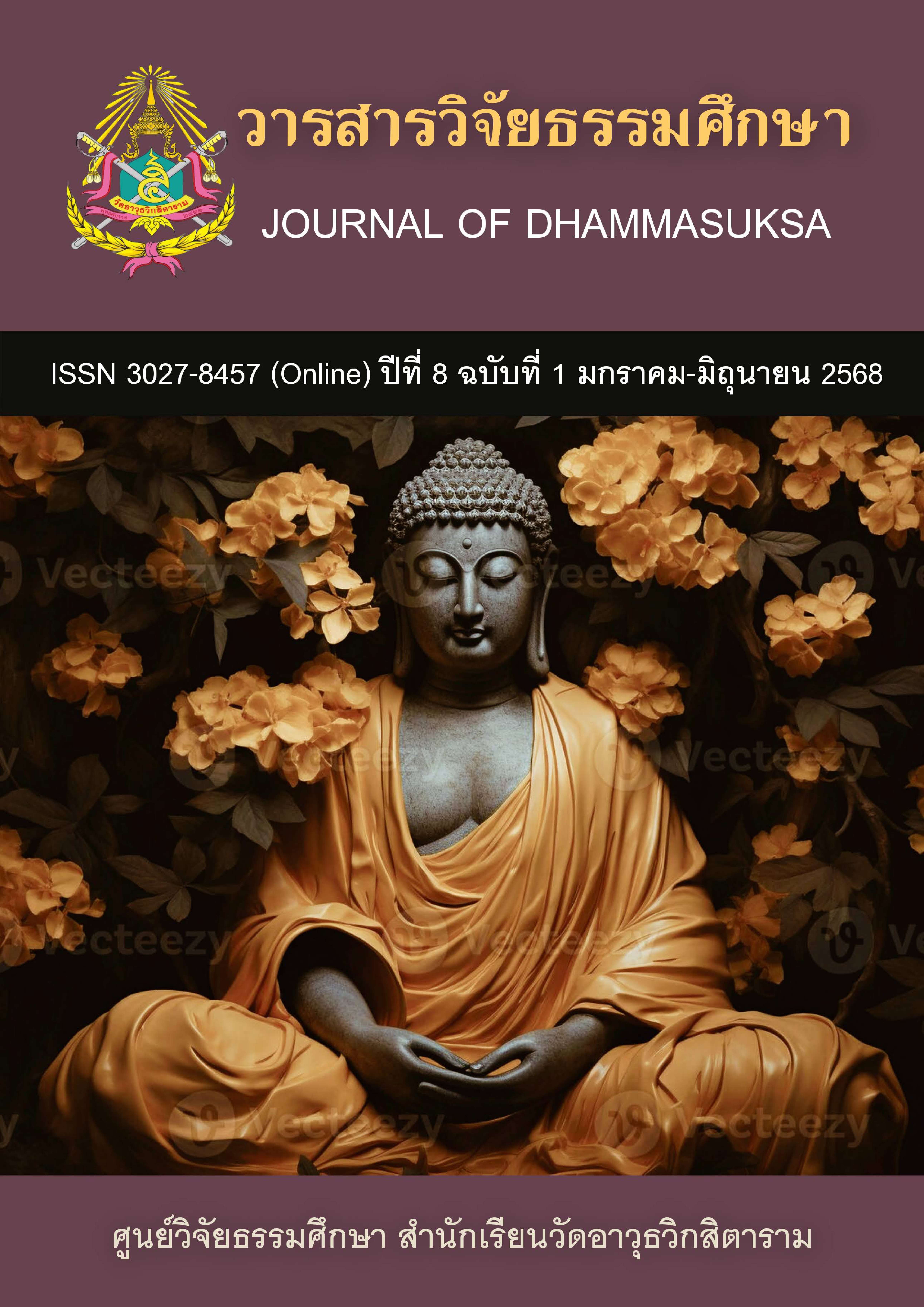Factors influencing the effectiveness of private vocational education business management in Thailand
Keywords:
effectiveness, business management, private vocational education businessAbstract
In the present day, private vocational education serves a crucial role in developing a workforce that meets the demands of Thailand's labor market. Effective management capabilities are therefore essential to the success of private vocational institutions. This academic article aims to investigate the factors influencing the effectiveness of private vocational education management in Thailand. The study identifies three key categories of influencing factors. 1)Institutional Management Factors: These include organizational dynamics, environmental conditions, and administrative policies and practices. 2) 21st-Century Leadership Competencies: These encompass results-based management, teamwork, transformational leadership, analytical and synthetic thinking, personnel capacity development, and ethical integrity. 3) Branding Factors: These are defined by brand positioning, brand personality, brand identity, and brand communication. These factors collectively contribute to the effectiveness of private vocational education management, which can be measured through six observable variables: employee job satisfaction, student learning outcomes, budget management, personnel management, academic administration, and general administration. The insights gained from this study are expected to strengthen private vocational institutions and drive the development of educational quality in alignment with international standards and the expectations of stakeholders across all sectors.
References
กระทรวงการต่างประเทศ. (2565). กระทรวงการต่างประเทศหารือความคืบหน้าและแนวทางส่งเสริม การลงทุนจากต่างประเทศในเขตพัฒนาพิเศษภาคตะวันออก (อีอีซี) ในการประชุมหารือทางไกลกับสำนักงานคณะกรรมการนโยบายเขตพัฒนาเศรษฐกิจพิเศษภาคตะวันออก. สืบค้นเมื่อ 10 กันยายน 2567 จาก https://www.mfa.go.th/th/content/eecconsultative/
meeting010264.
ดวงใจ แก้วประเสริฐ. (2565). ประสิทธิผลการบริหารสถานศึกษาในยุคการเปลี่ยนแปลงทางการศึกษา. วารสารบริหารการศึกษา, 12(2): 45 - 58.
นวรัตน์ รามสูต. (2567). ประเทศไทยเป็นเจ้าภาพจัดการประชุมรัฐมนตรีด้านการศึกษาของอาเซียน ครั้งที่ 13. สืบค้นเมื่อ 15 กันยายน 2567 จาก https://shorturl.asia/vXYUS.
พรรณิภา งามเลิศ, ประกฤติ พูลพัฒน์, และรุ่งนภา ตั้งจิตเจริญกุล. (2564). การพัฒนาตัวบ่งชี้คุณธรรมจริยธรรมสำหรับผู้บริหารสถานศึกษาอาชีวศึกษาเอกชนในจังหวัดกรุงเทพมหานคร. วารสาร มจร อุบลปริทรรศน์, 6(2): 543 – 558.
โครงการเขตพัฒนาพิเศษภาคตะวันออก (EEC.). (2563). ประมาณการความต้องการบุคลากรในเขตพัฒนาพิเศษภาคตะวันออกปี 2562 – 2566. สืบค้นเมื่อ 15 กันยายน 2568 จาก https://www.eeco.or.th/th/eec-model.
ศิริวัฒน์ มหากิจไพบูลย์. (2564). การพัฒนาระบบการบริหารจัดการสถานศึกษาเพื่อความยั่งยืน. วารสารการบริหารการศึกษาและนวัตกรรมการศึกษา, 10(3): 72 - 89.
ศศิธร วัฒนกิจ. (2565). การบริหารธุรกิจการศึกษาในประเทศไทย. กรุงเทพฯ: ศูนย์หนังสือจุฬาลงกรณ์มหาวิทยาลัย.
สุชาติ ภัทรกุลวณิชย์. (2564). การบริหารการศึกษายุคใหม่. กรุงเทพฯ: สำนักพิมพ์มหาวิทยาลัยธรรมศาสตร์.
สุทธิลักษณ์ หวังสันติธรรม. (2567). กลยุทธ์การสร้างแบรนด์: สรรค์สร้าง สื่อสาร ส่งเสริมแบรนด์ให้เติบโต. กรุงเทพฯ: สำนักพิมพ์จุฬาลงกรณ์มหาวิทยาลัย.
สำนักติดตามและประเมินผลการอาชีวศึกษา. (2565). สภาพปัญหา ข้อเสนอแนะของสถานศึกษาในการขับเคลื่อนการจัดการอาชีวศึกษาปีงบประมาณ พ.ศ. 2565. สืบค้นเมื่อวันที่ 18 กันยายน 2567 จาก https://bme.vec.go.th/Portals/30/PDF%20Documents/
policy%20report%202565.pdf.
อมิตรา อุดม, วาโร เพ็งสวัสดิ์ และทรัพย์หิรัญ จันทรักษ์. (2567). การวิเคราะห์องค์ประกอบ สมรรถนะของผู้บริหารสถานศึกษาในศตวรรษที่ 21. วารสาร มจร.หริภุญชัยปริทรรศน์, 8(3): 131 - 143.
Aaker, D. A. (2010). Brand relevance: Making competitors irrelevant. San Francisco: John Wiley & Sons Inc.
Anderson, J., Rourke, L., Garrison, D. R., & Archer, W. (2022). The impact of digital technologies on educational management: A case study of digital transformation in schools. Educational Administration Quarterly, 58(2): 123-145.
Anderson, L. W., Krathwohl, D. R., & Airasian, P. W. (2022). A taxonomy for learning, teaching, and assessing: A revision of Bloom's taxonomy of educational objectives. Longman.
Bass, B. M., & Riggio, R. E. (2006). Transformational leadership (2nd ed.). New York: Psychology Press.
Bronfenbrenner, U. (1979). The Ecology of Human Development: Experiments by Nature and Design. Massachusetts: Harvard University Press.
Brown, M. E., & Treviño, L. K. (2006). Ethical leadership: A review and future directions. The Leadership Quarterly, 17(6): 595 - 616.
Caldwell, B. J., & Spinks, J. M. (2013). The self-managing school. Oxfordshire : Routledge.
Drucker, P. F. (1993). Management: Tasks, Responsibilities, Practices. New York: Harper Business.
Fullan, M. (2021). The new meaning of educational change (5th ed.). New York: Teachers College Press.
Garavan, T. N., Carbery, R., & Rock, A. (2021). Strategic human resource development: A journey in progress. Oxfordshire: Routledge.
Heuer, R. J. (1999). Psychology of intelligence analysis. Center for the Study of Intelligence.
Hoy, W. K., & Miskel, C. G. (2013). Educational administration: Theory, research, and practice (9th ed.). New York: McGraw-Hill Education.
Robbins, S. P., & Judge, T. A. (2022). Organizational behavior (19th ed.). London: Pearson.
Robbins, S. P., & Coulter, M. (2020). Management (15th ed.). London: Pearson.
Robinson, V. (2009). The impact of leadership on student outcomes: Making sense of the evidence. Australian Council for Educational Research.
Kapferer, J. N. (2012). The new strategic brand management: Advanced insights and strategic thinking (5th ed.). London: Kogan Page.
Kaplan, R. S., & Norton, D. P. (1996). The Balanced Scorecard: Translating Strategy into Action. Massachusetts: Harvard Business Review Press.
Kaplan, R. S., & Norton, D. P. (2004). Strategy maps: Converting intangible assets into tangible outcomes. Massachusetts: Harvard Business School Press.
Keller, K. L. (2013). Strategic brand management: Building, measuring, and managing brand Equity (4th ed.). London: Pearson.
Kotler, P., & Keller, K. L. (2016). Marketing management (15th ed.). London: Pearson
Lawrence, P. R., & Lorsch, J. W. (1967). Organization and Environment: Managing Differentiation and Integration. Massachusetts: Harvard University Press.
Lencioni, P. (2016). The ideal team player: How to recognize and cultivate the three essential virtues. San Francisco: Jossey-Bass.
Mintzberg, H. (1979). The Structuring of Organizations. New Jersey: Prentice Hall.
Schultz, D. E., Patti, C. H., & Kitchen, P. J. (2020). The evolution of integrated marketing communications: The customer-driven marketplace. Oxfordshire: Routledge.
Spector, P. E. (1997). Job satisfaction: Application, assessment, cause, and consequences. California: Sage.
Stein, M. K., & Kim, G. (2009). Leadership content knowledge. Educational Administration Quarterly, Year 45 No.2. April - June 2009 : 219 - 258.
Sriputta, P., Agsonsua, P., & Sirisuthi, C. (2023). The development of an effective private school management model in the northeastern region of Thailand. International Journal of Higher Education, 12(5): 13 - 20.
Yang, C., and Sigdel, B. (2023). The impact of higher education service on institutional brand in Thailand: The mediating role of Chinese students’ satisfaction. The EUrASEANs: Journal on Global Socio-economic Dynamics, 6(43): 417 - 429.
Downloads
Published
How to Cite
Issue
Section
Categories
License
Copyright (c) 2025 Journal of Dhammasuksa Research

This work is licensed under a Creative Commons Attribution-NonCommercial-NoDerivatives 4.0 International License.



